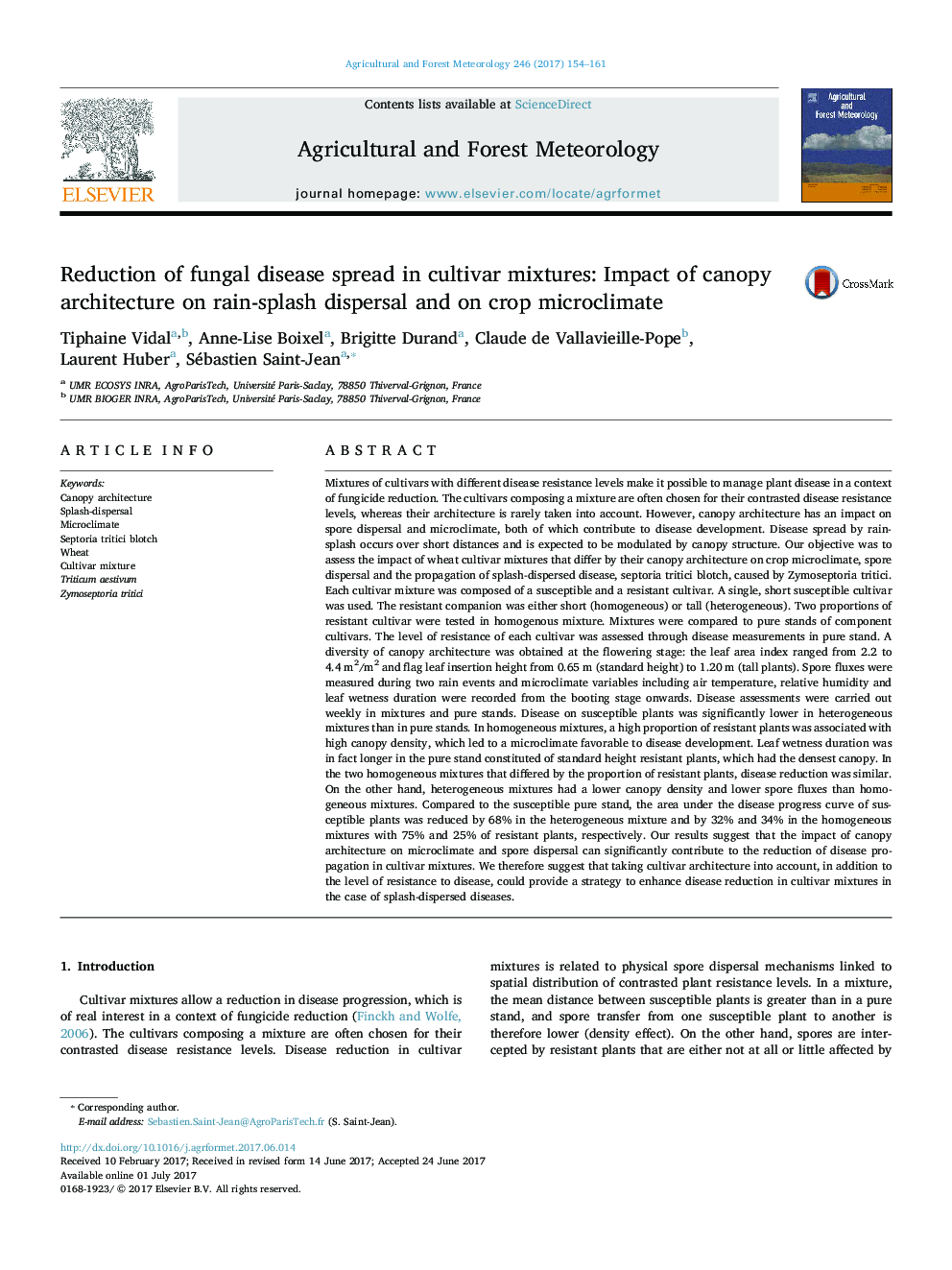| کد مقاله | کد نشریه | سال انتشار | مقاله انگلیسی | نسخه تمام متن |
|---|---|---|---|---|
| 6457708 | 1420855 | 2017 | 8 صفحه PDF | دانلود رایگان |
- Mixture of cultivars with contrasted height enhanced control of splash dispersed disease.
- Canopy architecture had an effect on both spore dispersal and microclimate.
- High canopy density reduced spore transfer between susceptible plants.
- Dense canopies had a long leaf wetness duration, favorable to pathogen development.
Mixtures of cultivars with different disease resistance levels make it possible to manage plant disease in a context of fungicide reduction. The cultivars composing a mixture are often chosen for their contrasted disease resistance levels, whereas their architecture is rarely taken into account. However, canopy architecture has an impact on spore dispersal and microclimate, both of which contribute to disease development. Disease spread by rain-splash occurs over short distances and is expected to be modulated by canopy structure. Our objective was to assess the impact of wheat cultivar mixtures that differ by their canopy architecture on crop microclimate, spore dispersal and the propagation of splash-dispersed disease, septoria tritici blotch, caused by Zymoseptoria tritici. Each cultivar mixture was composed of a susceptible and a resistant cultivar. A single, short susceptible cultivar was used. The resistant companion was either short (homogeneous) or tall (heterogeneous). Two proportions of resistant cultivar were tested in homogenous mixture. Mixtures were compared to pure stands of component cultivars. The level of resistance of each cultivar was assessed through disease measurements in pure stand. A diversity of canopy architecture was obtained at the flowering stage: the leaf area index ranged from 2.2 to 4.4Â m2/m2 and flag leaf insertion height from 0.65Â m (standard height) to 1.20Â m (tall plants). Spore fluxes were measured during two rain events and microclimate variables including air temperature, relative humidity and leaf wetness duration were recorded from the booting stage onwards. Disease assessments were carried out weekly in mixtures and pure stands. Disease on susceptible plants was significantly lower in heterogeneous mixtures than in pure stands. In homogeneous mixtures, a high proportion of resistant plants was associated with high canopy density, which led to a microclimate favorable to disease development. Leaf wetness duration was in fact longer in the pure stand constituted of standard height resistant plants, which had the densest canopy. In the two homogeneous mixtures that differed by the proportion of resistant plants, disease reduction was similar. On the other hand, heterogeneous mixtures had a lower canopy density and lower spore fluxes than homogeneous mixtures. Compared to the susceptible pure stand, the area under the disease progress curve of susceptible plants was reduced by 68% in the heterogeneous mixture and by 32% and 34% in the homogeneous mixtures with 75% and 25% of resistant plants, respectively. Our results suggest that the impact of canopy architecture on microclimate and spore dispersal can significantly contribute to the reduction of disease propagation in cultivar mixtures. We therefore suggest that taking cultivar architecture into account, in addition to the level of resistance to disease, could provide a strategy to enhance disease reduction in cultivar mixtures in the case of splash-dispersed diseases.
Journal: Agricultural and Forest Meteorology - Volume 246, 15 November 2017, Pages 154-161
